Actualidad
Medjoul Dates from Morocco for the World
A visit to Elbssita farm in the province of Er-Rachidia, where an extensive modern production area for dates is under development, now spanning 16,000 hectares

Several date palm groves in Morocco occupy various valleys where dates have "always" been produced for local markets. Since the beginning of this century, however, there has been a marked shift toward modern cultivation, focusing mainly on the prized "Medjoul" variety. All dates are delicious, but in this case, there is a consensus that Medjoul dates are among the very finest. New plantations now cover 16,000 hectares in the region near Elrachidia, operated by around ten companies with large holdings, along with others that manage smaller plots.
We had the opportunity to visit Elbssita farm, thanks to Professor Abdel Hanafi, organizer of the All Africa Horticultural Congress (Marrakech, February 2024), who, through Professor Abdelouahhab Zaid, connected us with Rachid El Bssita of Domaines Agricoles Rom, who graciously welcomed us to his establishment.
Date Production Worldwide
According to Blog Agricultura, based on FAOSTAT data from the year 2000, global date production reached 9,454,213 tons, cultivated on a harvested area of 1,235,601 hectares, yielding an average of 7.7 tons per hectare as per FAOSTAT data for 2020.
Nearly 50% of global production (47.8%) is concentrated in three countries. Egypt, the leading producer, accounts for 1.691 million tons, followed by Saudi Arabia with 1.541 million tons, and Iran in third place with 1.283 million tons.
In terms of yield, Egypt, Kuwait, and Albania lead with 33.3, 30.5, and 29.9 tons per hectare, respectively. The global average yield stands at 7.7 tons per hectare.
El Bssita: One of the Leading Date Farms in Boudnib
The El Bssita company encompasses 500 hectares across three farms in the municipality of Boudnib, located in the Drâa-Tafilalet region. Tafilalet is a historic oasis region in southeastern Morocco through which the Ziz River flows in the province of Errachidia (also known as Er-Rachidia, with a capital of the same name). This river originates in the Middle Atlas mountains and flows toward Algeria, ultimately disappearing into the sands of the Sahara.
Erfoud and Rissani are notable cities in the region; the latter hosts a local market with numerous date stalls. In late October, during the date harvest, the Date Fair is held in Errachidia’s capital, Er-Rachidia. Abdellatif Souly, El Bssita's Director General of Production, shares that Boudnib aims to become the “California of Dates.” This municipality hosts approximately 16,000 hectares of date production, divided among ten major farms, including El Bssita, as well as smaller farms, all equipped with modern technology. The region’s development began in 2011, with El Bssita starting operations in 2014, at which time there were only three or four other farms in the area.
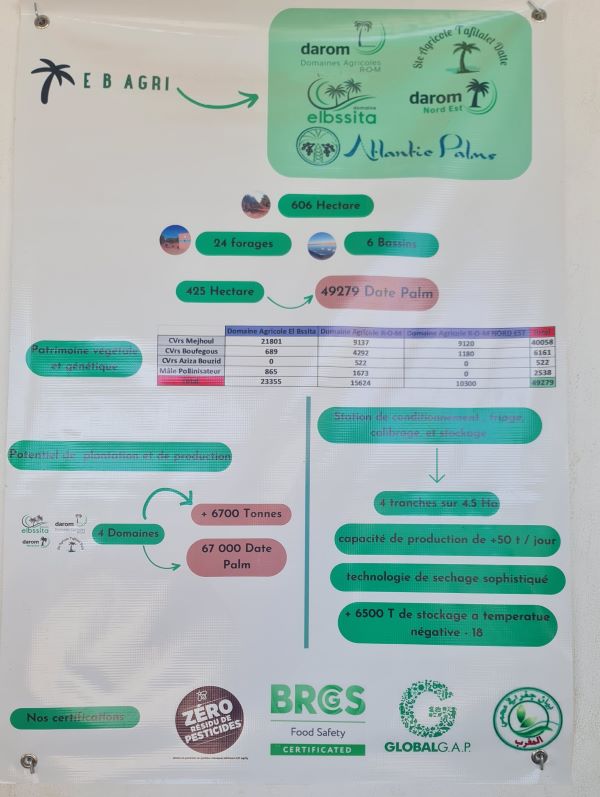
Overview of El Bssita Plantations and Quality Certifications
Of El Bssita’s roughly 500 hectares, the first farm (176 ha) and the second (148 ha) are already planted. Preparation is underway on the third farm, which spans 184 hectares and is scheduled for planting in March. The first farm has a planting framework of 8x8 meters, with 126 plants per hectare, while the second farm follows a 9x9 meter framework, yielding 123 plants per hectare.
Abdellatif Souly, with a background in citrus production, has managed El Bssita since its inception, overseeing each development stage—from land preparation and planting to reservoir construction and infrastructure.
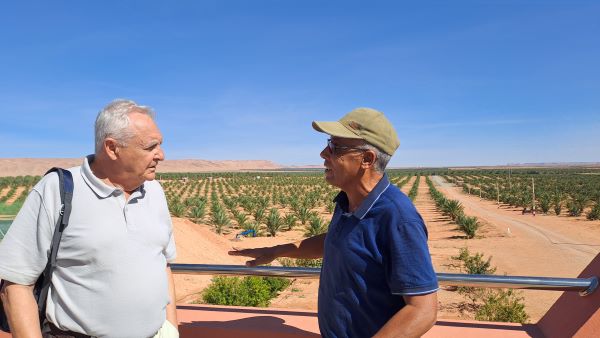
Abdellatif Souly, Director General of Production at El Bssita (right), with Pere Papasseit, founder of Ediciones de Horticultura and SPE3
Madjol: A Delicious, Semi-Dry Date Variety
The main date variety cultivated at El Bssita is Majhül or Madjol—also known as Medjoul—which is highly prized in international markets. This variety originates from the Tafilalet region but is now also grown in the United States, Israel (the world’s largest producer, holding a 60% market share), Mexico, Iran, Saudi Arabia, South Africa, Jordan, Palestine, and Peru. Native to the Tafilalet area, Medjoul dates spread to California and Israel through Moroccan Jewish migrations.
The date palm, Phoenix dactylifera, is used in landscaping as well and thrives in warm, arid climates typical of subtropical regions.
Dates are categorized not only by variety but also by their ripeness at harvest, depending on how much they mature on the palm. Soft or fresh dates are harvested after a short ripening period, are juicier, and require refrigeration. Semi-dry dates are the most commonly consumed and include the Madjol (or Tamara, the general term for ripe dates). Dry dates, on the other hand, are picked after a prolonged ripening period during which they fully dehydrate on the tree.
The Madjol date can reach up to 5 cm in length and turns dark brown when perfectly ripe. Its skin is glossy and wrinkled, while the flesh remains exceptionally soft, making it ideal for desserts or for creating date syrup.
Other notable varieties include Deglet Nour (also called Muscatel or “Date of Light”), Zahidi, Halawi (closely related to the similar-sounding Hadrawi), and Barhi. These varieties, along with others, are described in El mundo del dátil.
Cultivation
Date propagation relies on basal offshoots from the palms; at El Bssita, male plants are grouped in rows, and an Israeli-made device is used for pollen extraction, allowing it to be stored for later use. Pollination is done with a backpack sprayer. After the offshoots are removed from the main plants, they grow under mesh shelters until they reach a suitable size for planting, a process that typically takes 8 to 10 months. Field planting is set to begin in March.
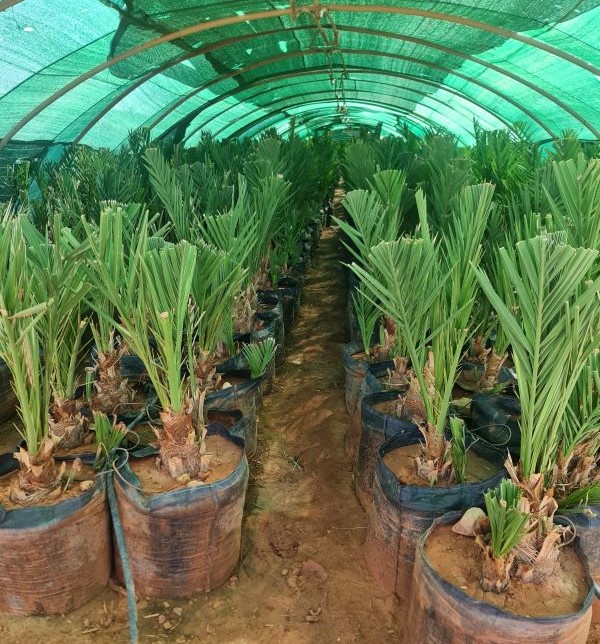
The plantation is equipped with drip irrigation, providing each plant with four 25 L/h emitters, two on each side, irrigating for four hours during summer. Low ridges mark the rows and individual spaces between plants; these ridges also help prevent erosion in case of rain.
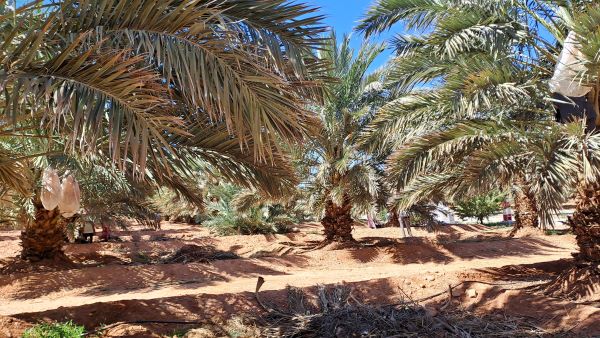
Medjoul palm plantation in plots outlined by raised ridges
Water is drawn from a 200-meter-deep well, delivering a flow rate of 15 to 20 liters per second and an electrical conductivity of 1.5 (date palms can tolerate up to 7). The water is then directed to a reservoir.
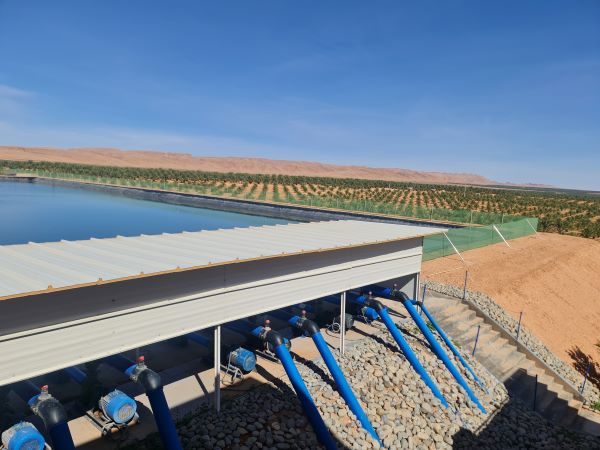
The palms alternate bearing years, with each rachis marked to track the number of clusters produced each season.
Health issues are minimal and include mites, which appear around March or April and are controlled by predators, and scale insects, for which oil treatments are applied. The primary fungal concern is "Bayoud disease," named after the Arabic word for "white" due to the discoloration it causes on the leaves, caused by Fusarium oxysporum f.sp. albinism. First identified in Morocco in 1870, this disease is the main reason the plantation maintains its nursery.
Fertilization includes NPK and manganese, while herbicide use is strictly prohibited.
Pollination occurs in January and February. After the fruit set, smaller or defective clusters are removed.
Each plot in the plantation is equipped with separate washrooms for male and female workers. About 250 employees work year-round, living in nearby areas, with company-provided minibusses for transport.
Harvest
The harvest period extends from late September to early December, varying slightly each year. Harvesting takes place in 4 or 5 rounds. Once the dates begin to ripen, around July, each cluster is enclosed in a mesh bag that allows airflow while preventing insects from entering. One of the bag’s lower corners is tied in a knot, which, when opened, allows harvesters to collect the mature dates into a bucket.
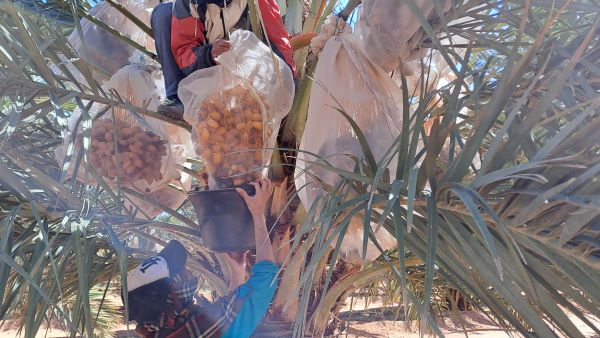
The dates go directly from the cluster to the collection bucket
The initial sorting occurs in the field, separating damaged dates and categorizing them by color.
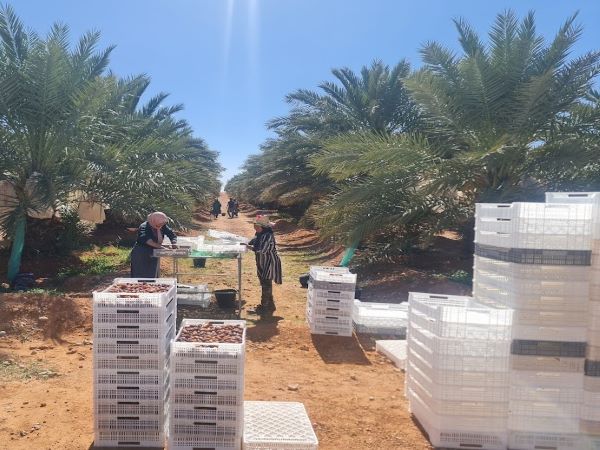
First sorting in the field
In the packinghouse, the dates undergo heat treatment for 6 to 8 hours at 52°C to prevent the development of the date moth, Ectomyelois ceratoniae. Dates that haven't yet reached the ideal dark brown color are left in the sun for one or two days until they reach the desired ripeness.
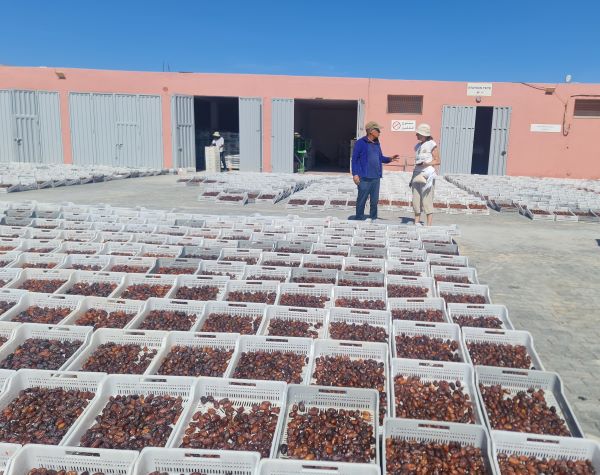
Dattes with a low color grade (immature) are sun-dried until they acquire the dark brown color characteristic of the Medjoul variety.
Postharvest
The packaging warehouse at El Bebita, which is in an advanced stage of construction, features two cold storage rooms for freshly harvested dates (0 to -3 ºC) and six chambers for long-term preservation at approximately -20 ºC.
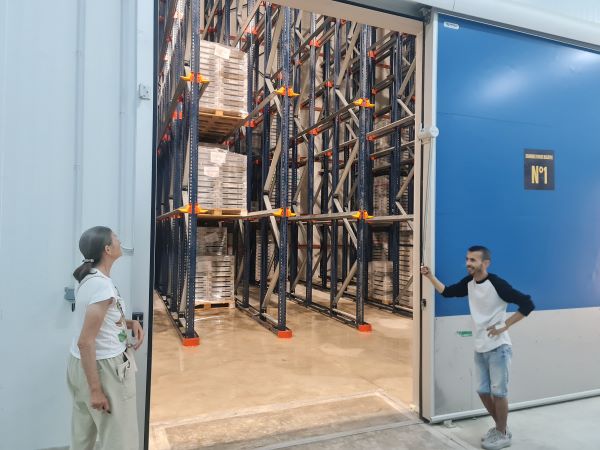
The packaging area is equipped with a Unisorting line from UNITEC that has 28 outputs, along with space for several additional lines, which will also be used for processing machinery. This equipment handles tasks that would otherwise require 200 workers to manually sort the fruits.
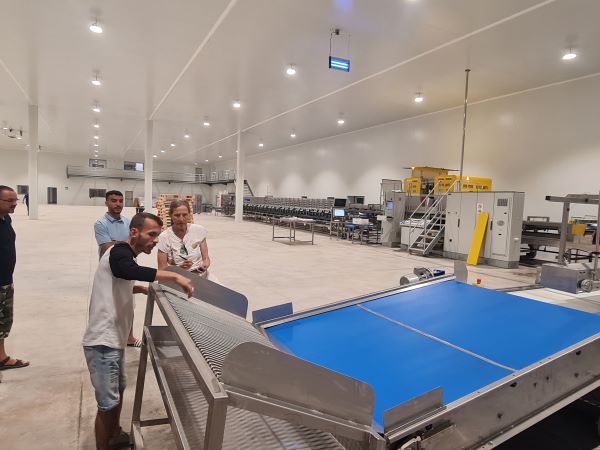
Start of the sorting and grading line
Immediately after the boxes are emptied, the dates pass through a separation stage using rods to eliminate any that are too small and may have slipped through the initial sorting in the field. Next, they are washed using brushes that transport the dates while they receive a shower from nozzles situated above the rollers. Drying follows this step, utilizing ambient air. After drying, the dates enter the sorting line, starting with singulation, which allows for the individual evaluation of each date based on size, defects, and color.
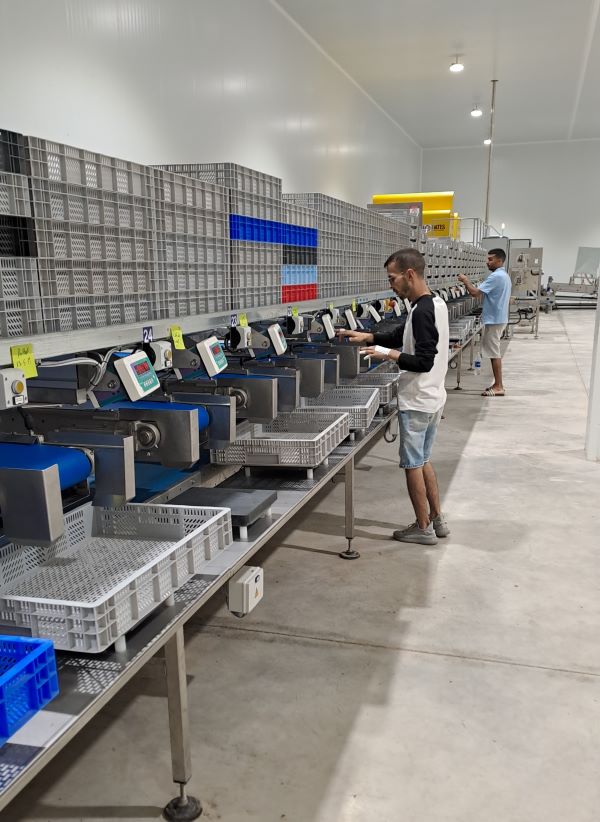
The storage line has 28 outlets; during the visit, specifications were being prepared for a client
In Elbssita, the initially planted plots are just starting to produce; this is the second year with significant volumes, and some operations are still carried out in facilities that will be consolidated next year in the building currently under construction.
This new construction will house the already installed packing line, with space for more lines and processing equipment, as well as cold storage chambers. The packinghouse manager, Ahmad Hajjat (shown in the main image), is a technician with years of experience in date production in Jordan.
The company marketing the dates is Atlantic Palm, which is under the same ownership. Rachid El Bssita is the sole owner at present; the sign at the entrance of the farm reads "El Bssita Freres" (brothers), but the other brother has already withdrawn from ownership. The company holds certifications that allow them to market their products in major global markets. A generous gift of boxes of dates allows us to assert, based on our own experience and that of guests, that they are exquisite!
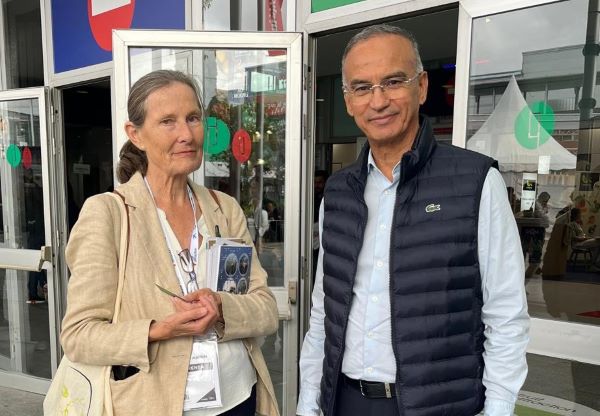
Rachid Elbssita during his visit to Fruit Attraction 2024 with the author
Diversification
At El Bssita, they are diversifying with almond plantations, having already established 50 hectares, a product of interest for markets focused on healthy eating.
Sources
R. Ben Amor, M.D de Miguel & E. Aguayo, sf, Aplicación de atmósferas controladas para la conservación de dátiles tunecinos Deglet Noor
El mundo del dátil: conoce todas sus variedades
Wikipedia, Dátil Majhūl













